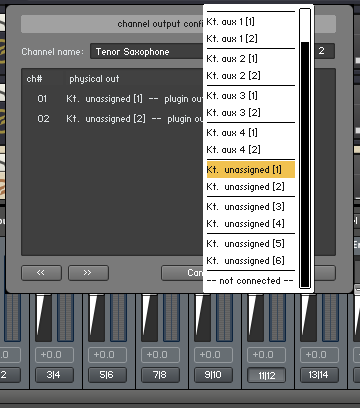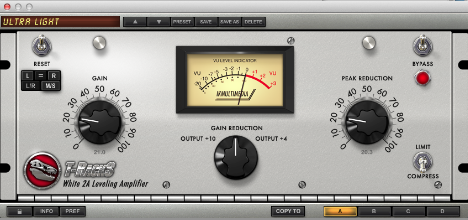I did a few more experiments, and the key to getting independent ReWire 2 output channels for the various instruments in the Kontakt 5 Multi is to start by selecting "Create separate Master Output Channel" for each instrument . . .

Then, you need to assign the output for the newly created Master Output Channel to a ReWire 2 channel pair, which is done by clicking on the channel-pair button at the bottom of the Kontakt 5 Mixer . . .
[
NOTE: If you count them, you will see that there are 16 items, and they correspond to the 16 available outputs, where the pair not shown at the top is the pair of output channels for the default Stereo (st. 1, channels 1 and 2) . . . ]
 THOUGHTS
THOUGHTSIt appears that there are only eight possible channel pairs, where by default there is a Stereo channel pair and four Auxiliary channel pairs, plus additional tracks for each instrument, where each instrument is assigned its own track via the "Create separate Master Output Channel", where in the context "Channel" maps to what I am calling a "track" in the Kontakt 4 Mixer . . .
You can assign the first instrument to use the Stereo output channel pair; and you can assign the next four instruments to use one of the four Auxiliary output channel pairs; and then there are three more "unassigned" channel pairs that you can use for a total of eight output channel pairs running from 1-2 to 15-16 . . .
Hence, I think the applicable rule is that you want to limit each Kontakt 4 Multi to eight instruments, since this appears to be the maximum number of separate and independent output channel pairs that are available, based on what I have discovered and verified so far . . .
This appears to be a limitation imposed by NOTION 4, which only provides MIDI Port A and 16 channels, at least insofar as the Kontakt 5 Multi sees it, although it might be a limitation imposed by Kontakt 5 . . .

To make sense of this I created a second Kontakt 5 Multi, and it also sees MIDI Port A with 16 channels, but in the NOTION 4 Mixer you can assign as many as 32 ReWire 2 channel pairs, so while Kontakt 5 outputs to 8 channel pairs, which apparently are MIDI Port A and Channels 1-16, each Kontakt 4 Multi is unique insofar as NOTION 4 is concerned, so the key is to use a different set of ReWire 2 channel pairs for the second Kontakt 5 Multi; and I verified that this works correctly with Digital Performer 8 (MOTU) . . .
It is a bit confusing visually, since doing it this way maps to having two identically named tracks, but it makes sense when you understand the logic, where the first Kontakt 4 Multi is first and the second Kontakt 4 Multi is second, even though they have the same names, as shown in the following screen capture . . .
[
NOTE: These two tracks have the same display name ("Kntkt 5-6"), but in the NOTION 4 Mixer I have them routed to two separate and independent ReWire 2 channel pairs ("Ch 5-6" and "Ch 21-22", respective); and each of the NOTION 4 channel pairs has the correct output, where the "Ch 5-6" pair is the output from the respective instrument in the first Kontakt 5 Multi, while the "Ch 21-22" pair is the output from the second Kontakt 5 Multi, which is fine with me . . . ]

Consequently, I think these are the general rules:
(1) Each Kontakt 5 Multi can have eight instruments, each of which has its own output channel pair for ReWire 2, because there are 16 channels available per Kontakt 5 instance . . .
(2) NOTION 4 supports 32 ReWire 2 channel pairs (64 individual channels) . . .
(3) You can have a maximum of four Kontakt 5 Multis, each of which has 8 instruments each with its own output channel pair for ReWire 2, for a total of 32 output pairs, but the display names will be identical in groups of four at the maximum, even though they are kept separate and distinct insofar as NOTION 4 ReWire 2 channel pair assignment is concerned . . .
(4) This tends to provide the clue that having more than 64 instruments in a single NOTION 4 score is a bit much . . .
The strategy for digital music production I use here in the sound isolation studio is based in part on limiting the number of instruments in a single NOTION 4 score, and I usually limit it to approximately 20 instruments per NOTION 4 score, although with some of the heavier VSTi virtual instruments I reduce the total to perhaps 10 or fewer, which depends primarily on how "heavy" each VSTi virtual instrument and its associated sound samples happens to be, which MachFive 3 (MOTU) being one of what in the days of mainframe computers were called "core hogs", where the upside is that the MachFive 3 instruments are so highly sampled that they sound marvelous, which is fine with me . . .
Hence, instead of having one NOTION 4 score for a
DISCO or
Pop song, I will have as many as 10 or more of synchronized NOTION 4 scores, each with a few common instruments for "where are we in the song?" purposes but otherwise a different set of instruments; and this keeps everything synchronized, where the general strategy is to record the NOTION 4 generated audio as soundbites in Digital Performer 8 for each NOTION 4 score, which is an iterative process that begins with the basic rhythm section for the song, where the following is an example of a prototype basic rhythm section for song I am developing based on an earlier version that was on The Surf Whammys first album but at a time before I switched to music notation and virtual instruments and had not discovered the secret to producing, mixing, and mastering, hence sounded really bad, even though it is a great song, where for reference the secret is to use a calibrated full-range studio monitor system so that you can hear accurately the raw audio material, which is the only practical way to produce, mix, and master . . .
[
NOTE: The short drops in audio level are caused by the screen and audio capture program (Screenflow [Telestream]) overwhelming the Mac Pro, since everything is happening in real-time during the screen and audio capture. This doe not happen when the NOTION 4 audio is recorded as soundbites in Digital Performer 8 in a ReWire 2 session, hence it is a relic of running the Mac Pro at the upper limit of what it can handle in real-time. And since I am planning to record real lead guitar next, I have the snare drum rimshots louder to use as aural cues which also is the way I use cowbells, because I need to hear the beat distinctly when I am playing lead guitar. Overall, there might be 5 to 10 more NOTION 4 scores for this song; and once everything is recorded, I switch focus to producing, mixing, and mastering and adjust levels for everything to fit the complete song, where the electric bass trills at the end of the song are another set of aural cues, which is necessary because when I play lead guitar I focus so intently on playing lead guitar that at times I actually start drooling and forget where I am . . . ]
"Dance Baby Dance" (The Surf Whammys) ~ Basic Rhythm Section 2014 ~ YouTube music videoThis is the original version of the song, which was done when I was doing everything with real instruments and played or sang each part exactly one time in real-time on the fly, which was an interesting experiment that was based on misunderstanding something an audio engineer to me about Paul McCartney when he was doing the "R.A.M." album, which was that McCartney did everything either on the first take or occasionally on the second take, which I thought was vastly cool, so I did this for several years and continue to do it for lead guitar, where at first it literally is frightening but after a while it becomes natural and you discover that you can do it, which among other things might be the best way to discover how to rewire your brain to create more neural pathways from your auditory cortex to the frontal eye fields region of your brain, which for reference is the only way one can play lead guitar or any other instrument extremely rapidly while composing in real-time on the fly, since the auditory response in the frontal eye fields region of the brain is as fast as 24 milliseconds with response to auditory characteristics in the range of 30 to 60 milliseconds, where in contrast the auditory response in the auditory cortex is in the range of 60 milliseconds, which is a roundabout way of explaining that the only way to compose and play rapidly in real-time is to do it without any immediately conscious thought, since immediately conscious thinking is too slow . . .
"Dance Baby Dance" (The Surf Whammys) ~ 2007 ~ MP3Another way to explain it is that it is like being beamed with a lead guitar and amplifier onstage at an Elvis Presley concert, and Elvis looks over at you and says, "Take it!", followed by a spotlight appearing, and then there you are, which in some respects is "Come to Jesus!" time, because you either play a stellar lead guitar solo or runaway, and here in the sound isolation studio running away is not an option, which is fabulous . . .
Fabulous! 





